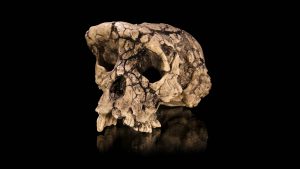
Sahelanthropus tchadensis, described in 2002 by French paleontologist Michel Brunet and his team, was discovered at a site known as Toros Menalla located in Chad, central Africa, from deposits whose age was estimated by biostratigraphy to be between 6.0 and 7.0 million years ago. However, the site was subsequently redated, using a new method of radiometric dating known as cosmogenic nuclide, to between 6.8 and 7.2 million years ago. Central Africa is an unusual and totally unexpected place to find hominin fossils. The discovery of S. tchadensis outside eastern and South Africa, where almost all of the early hominin fossils older than 2.0 million years have been found, challenged what is known as the “east side story,” a hypothesis proposed by French paleontologist Yves Coppens more than 40 years ago. This hypothesis suggested that the earliest hominins would be found within the eastern African Rift Valley. The discovery of S. tchadensis not only falsified Coppens’ hypothesis—this species is the earliest hominin species known in the fossil record—but also documented a wider geographic spread of hominins across the African continent as early as their beginnings close to seven million years ago. Many fossils of other animals were recovered at the same site as S. tchadensis, suggesting that the habitat, a dry desert in the middle of the Sahara today, was then a lush lakeshore with extensive forests and grasslands around it.
The type specimen (holotype) of the species that was found by Brunet’s team was a badly crushed and distorted cranium nicknamed “Toumaï,” which means “hope of life” in the local Goran language. It is known by the specimen number TM-266-1. The cranium housed a small brain, estimated to be around 360 cc in volume. This is approximately the same size as a contemporary African ape. It is not surprising that a creature that lived so close to the divergence time of the human and chimpanzee lineages (according to molecular data) had a small brain. However, it also had relatively small canine teeth, which are worn down at the tip, in contrast to ape canines, which are large, projecting, and remain pointed throughout life.
The very large brow ridges of Toumaï are unexpected. This feature does not appear in human ancestors until Homo erectus, some 5.0 to 6.0 million years later—even though it still remains unknown as to why H. erectus had large brow ridges. The relative flatness of the facial features is also unexpected. Both apes and later hominins such as australopithecines are characterized by projecting faces. With its mixture of primitive, unusual, and advanced traits, Toumai gives us a glimpse into the beginning of the human lineage. However, whether it belongs on our branch or that of the apes cannot be definitively established until more fossils are found.
One of the most important questions about S. tchadensis was whether it walked on two legs like humans or was quadrupedal. Bipedality (walking on two legs) is one of the most diagnostic characteristics of humans and their ancestors. How can we tell if extinct hominins were bipedal? One way to tell from the skull (head) of an extinct hominin is by looking at the position of the foramen magnum (Latin for “great hole”) at the bottom of the braincase. While the spinal cord exits the skull through this large opening, its far forward position on the base of the braincase also demonstrates the upright posture seen in all hominins. In the Toumaï skull, the foramen magnum seems to be positioned fairly far forward, and this was interpreted by Brunet and his colleagues as indicating bipedal locomotion in Sahelanthropus. Other paleoanthropologists have questioned this conclusion largely based on the distorted preservation of Toumaï. However, Zollikofer and colleagues later reconstructed Toumaï digitally and reconfirmed that the foramen magnum was indeed positioned far forward as in later bipedal hominins. However, this was still controversial, and some paleoanthropologists argued that without fossil evidence of its postcranial skeleton, such as leg bones, its locomotion cannot be unequivocally determined as bipedal.
Recently, an article in the journal Nature described a femur (thigh bone) that was found in 2001, very close to Toumaï but not identified as its leg bone at that time, and two ulnae (lower arm bones) found nearby. While the femur was not formally described, its presence has been known to most paleoanthropologists as early as 2004. In the new publication, researchers describe both the femur and the two ulnae as belonging to S. tchadensis. They argued that the femur, which lacks its proximal and distal ends, has features that are consistent with bipedalism, while the arm bones were clearly adapted to climbing trees. While some researchers have argued that the femur does not have “smoking-gun” traces of bipedalism, they agree that it looks more like that of a bipedal hominin than that of a quadrupedal ape. However, the place of Sahelanthropus on the human family tree remains still unclear.